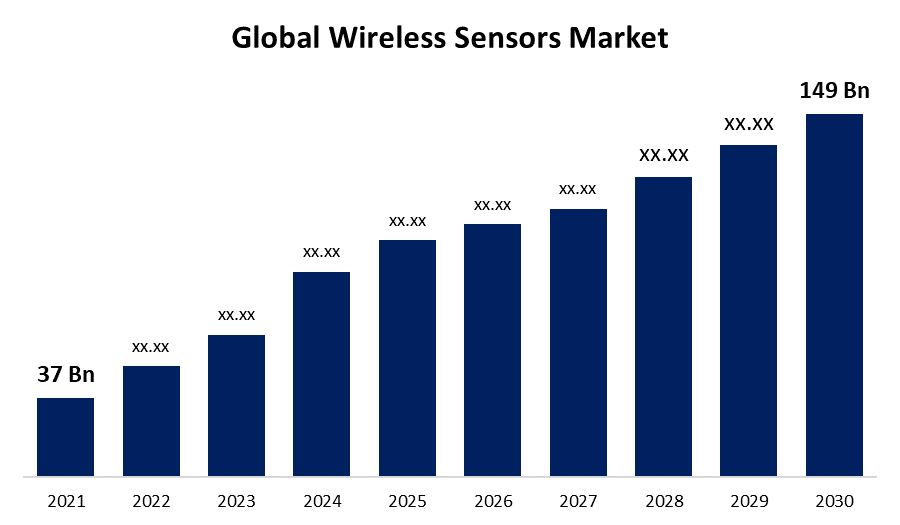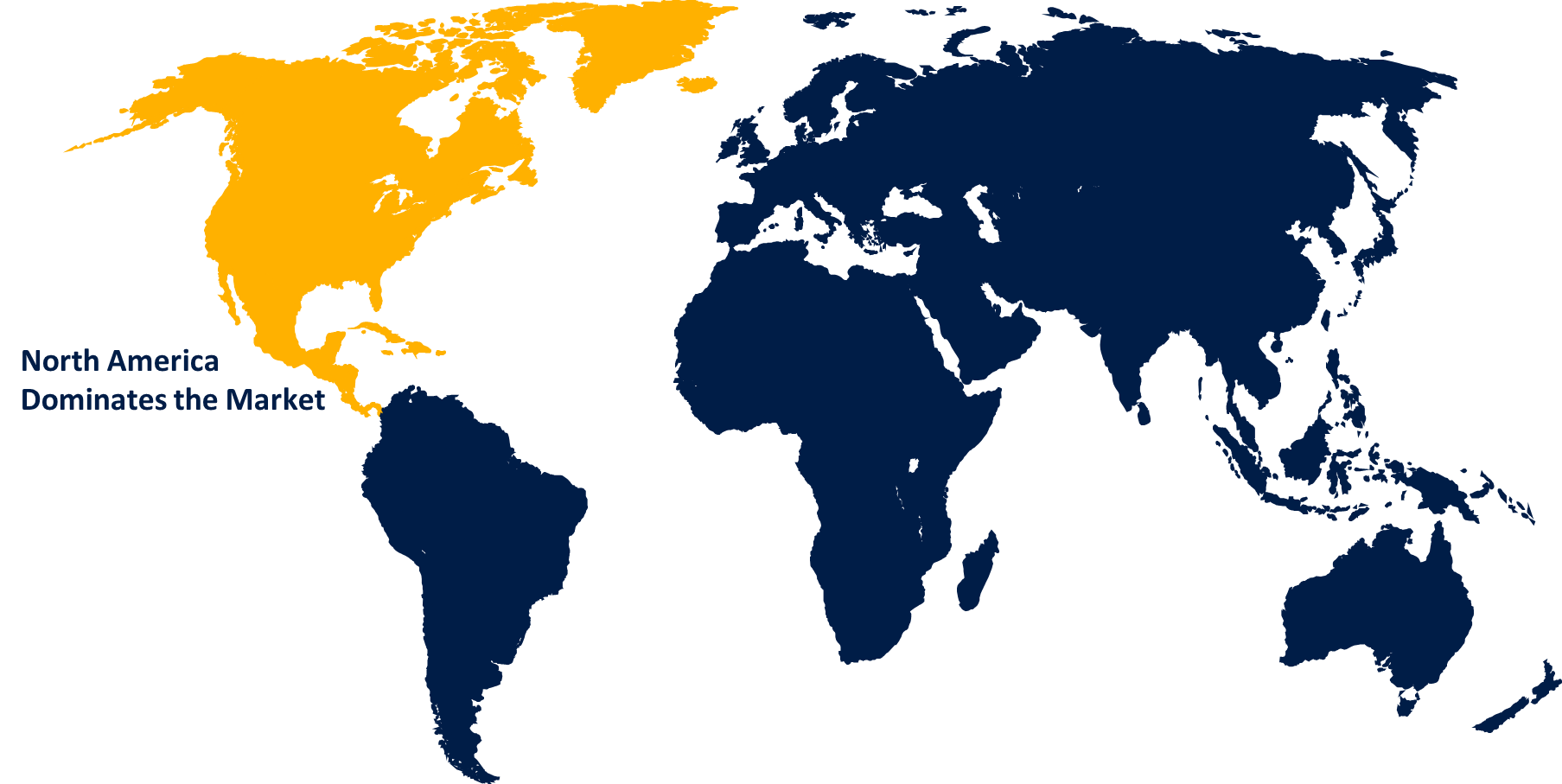Global Wireless Sensors Market Size, Share, and COVID-19 Impact Analysis, By Component (Hardware, Software, Services), By Connectivity Type (Bluetooth, Wireless Fidelity (Wi-Fi), Wireless Highway Addressable Remote Transducer (WHART), Cellular Network, Global Navigation Satellite System (GNSS) Module, and Bluetooth Smart/Bluetooth Low Energy (BLE)), By Sensor Type (CMOS based sensors, MEMS sensors, LED sensors, motion and position sensors, flow sensors, others), By Application (industrial automation, home building and automation, smart transportation, military surveillance, machine monitoring, patient monitoring, others), By End User (Building Automation Banking, Financial Services, and Insurance (BFSI), Industrial, Wearable Devices, Healthcare, Retail, Others), by Region (North America, Europe, Asia-Pacific, Latin America, Middle East, and Africa), Analysis and Forecast 2021 – 2030
Industry: Semiconductors & ElectronicsGlobal Wireless Sensors Market Insights Forecasts to 2030
- The Wireless Sensors market was valued at USD 37 billion in 2021.
- The market is growing at a CAGR of 19% from 2022 to 2030
- The global Wireless Sensors market is expected to reach USD 149 billion by 2030
- Asia Pacific is expected to grow the fastest during the forecast period

Get more details on this report -
The Global Wireless Sensors Market is expected to reach USD 149 billion by 2030, at a CAGR of 19% during the forecast period 2022 to 2030. The market's expansion is being fueled by the rise in popularity of wireless sensor networks. The market for wireless sensor networks is expanding due to rising demand for wearable and smart devices. The market for wireless sensor networks is expanding due to rising remote monitoring demand as well.
Market Overview
Wireless Sensor is a self-configured and infrastructure-less wireless network that detects physical or environmental conditions such as temperature, pressure, motion, sound, vibration, or pollution. Wireless sensor networks employ sensor nodes and an embedded CPU to regulate and keep an eye on the local environment. They are connected to the base station, which serves as the brain of the wireless sensor networks system. The processing speed, storage capacity, and transmission bandwidth of a sensor node in a wireless sensor network are all controlled by design.
Report Coverage
This research report categorizes the market for Wireless Sensors market based on various segments and regions and forecasts revenue growth and analyzes trends in each submarket. The report analyses the key growth drivers, opportunities, and challenges influencing the Wireless Sensors market. Recent market developments and competitive strategies such as expansion, product launch and development, partnership, merger, and acquisition have been included to draw the competitive landscape in the market. The report strategically identifies and profiles the key market players and analyses their core competencies in each sub-segments of the Wireless Sensors market.
Global Wireless Sensors Market Report Coverage
| Report Coverage | Details |
|---|---|
| Base Year: | 2021 |
| Market Size in 2021: | USD 37 Billion |
| Forecast Period: | 2021 - 2030 |
| Forecast Period CAGR 2021 - 2030 : | 19% |
| 2030 Value Projection: | USD 149 Billion |
| Historical Data for: | 2017 - 2020 |
| No. of Pages: | 220 |
| Tables, Charts & Figures: | 119 |
| Segments covered: | By Component, By Connectivity Type, By Sensor Type, By Application, By End User, By Region |
| Companies covered:: | Intel Corporation, Huawei Investment & Holding Co., Ltd., Dell Incorporation, Texas Instruments Inc., Cisco Systems Inc., Hewlett Packard Enterprise Co., NXP Semiconductors N.V., STMicroelectronics N.V., TE Connectivity Ltd., Advantech Co., Ltd., ABB, Honeywell International Inc., Broadcom, Bosch Connected Devices and Solutions GmbH, EUROTECH, InvenSense, Infineon Technologies AG, Analog Devices, Inc., Emerson Electric Co., Sensirion AG, Nordic Semiconductor, MediaTek Inc. |
Get more details on this report -
Driving Factors
The market's expansion is being fueled by the rise in use of wireless sensors. Industrial wireless sensor technology has become more popular recently because it enables companies to remotely manage and monitor a variety of characteristics, including temperature, vibration, pressure, and others while also saving a tonne of time. Additionally, as the drive to improve process efficiency and meet corporate financial goals develops, there is an increase in the demand for low-cost industrial automation systems, such as industrial wireless sensors. These systems also offer a variety of benefits over conventional wired industrial monitoring and control systems, including quick creation, adaptability, self-organization, and intelligent processing. The industry is also being advanced by their crucial role in creating a trustworthy and self-healing system that responds to real-time occurrences with appropriate responses. The market is expanding due to the rise in demand for remote monitoring. Wireless sensors, which have monitoring sites with low-power and low-cost WSNs, are revolutionising industrial monitoring and diagnostics. These networks, which are made up of battery-operated motes, are capable of forming a wireless network of sensors that can communicate with one another very quickly. Wireless sensors can be used in consumer-grade applications including home automation, PC peripherals, and remote controls. The expansion of the wireless sensor market is also being fueled by rising demand for smart and wearable devices.
Restraining Factors
Data security and privacy worries are limiting business expansion. Industrial wireless sensors, which remotely regulate, troubleshoot, and monitor multiple parameters including temperature, vibration, pressure, and others, have changed the control and monitoring process.
Market Segmentation
- In 2021, the Hardware Segment dominates the market with the largest market share.
Based on the component, the global wireless sensors market is segmented into hardware, software, services. Among these, the hardware segment dominates the market with the largest market share due to the increasing adoption of gateways, sensor nodes and routers to develop strong network infrastructure. Apart from this, increasing adoption of IoT as well as connected devices across several industrial applications is contributing towards the segmental growth. In addition, hardware installation enables the easy integration of data.
- In 2021,WHART segment is witnessing the fastest market growth over the forecast period.
On the basis of Connectivity Type, the global wireless sensors market is segmented into Bluetooth, Wireless Fidelity (Wi-Fi), Wireless Highway Addressable Remote Transducer (WHART), Cellular Network, Global Navigation Satellite System (GNSS) Module, and Bluetooth Smart/Bluetooth Low Energy (BLE). Due to its advantages, which include providing a user-friendly environment while maintaining interoperability with current devices, tools, and systems, the WHART segment dominated the market. A popular open wireless communication technology called WHART can also be used for process monitoring and measurement.
- In 2021, Motion and Position Sensor segment holds the highest market share over the forecast period.
Based on the sensor type, the global wireless sensors market is segmented into CMOS based sensors, MEMS sensors, LED sensors, motion and position sensors, flow sensors, others. Among these, the motion and position sensor segment is dominating the market with the highest market share over the forecast period as it is widely used to measure the rotary position of the object while using a whole range of sensing technologies.
- In 2021, Home Building and Automation segment is dominating the market over the forecast period.
On the basis of application, the global wireless sensors market is segmented into industrial automation, home building and automation, smart transportation, military surveillance, machine monitoring, patient monitoring, others. Among these, the home building and automation segment is dominating the market over the forecast period owing to the increasing adoption of wifi for the automation of home applications through wireless connections which will fuel the market growth.
- In 2021, Healthcare segment holds the largest market share over the forecast period.
Based on the end user, the global wireless sensors market is segmented into Building Automation Banking, Financial Services, and Insurance (BFSI), Industrial, Wearable Devices, Healthcare, Retail, and others. Due to wireless sensor networks' crucial contribution to the development of new technologies that enable patient monitoring, diagnosis, and therapy, the healthcare sector holds a substantial portion of the market. As healthcare systems advance, it is anticipated that the need of medical gadgets that can monitor daily activities and gather crucial data through sensors in emergency rooms will increase.
Regional Segment Analysis of the Wireless Sensors Market
- North America (U.S., Canada, Mexico)
- Europe (Germany, France, U.K., Italy, Spain, Rest of Europe)
- Asia-Pacific (China, Japan, India, Rest of APAC)
- South America (Brazil and the Rest of South America)
- The Middle East and Africa (UAE, South Africa, Rest of MEA)

Get more details on this report -
North America is dominating the market with the largest market share over the forecast period.
Two key reasons driving the growth of the Wireless Sensor Network Market in North America are the increased R&D in the IoT space in terms of technology and the rising need for better lifestyles. Additionally, the range of IoT applications is growing in fields including building automation, retail, automotive and transportation, and healthcare thanks to increased R&D at both the academic and industry levels.
Recent Developments
- In November 2019, the STM32WB50 Value Line of wireless microcontrollers was introduced by STMicroelectronics to meet the needs of connected devices that are on a budget but require compatibility with Bluetooth 5.0, ZigBee 3.0, or OpenThread.
Competitive Analysis:
The report offers the appropriate analysis of the key organizations/companies involved within the global Wireless Sensors market along with a comparative evaluation primarily based on their product offering, business overviews, geographic presence, enterprise strategies, segment market share, and SWOT analysis. The report also provides an elaborative analysis focusing on the current news and developments of the companies, which includes product development, innovations, joint ventures, partnerships, mergers & acquisitions, strategic alliances, and others. This allows for the evaluation of the overall competition within the market.
List of Key Companies
- Intel Corporation
- Huawei Investment & Holding Co., Ltd.
- Dell Incorporation
- Texas Instruments Inc.
- Cisco Systems Inc.
- Hewlett Packard Enterprise Co.
- NXP Semiconductors N.V.
- STMicroelectronics N.V.
- TE Connectivity Ltd.
- Advantech Co., Ltd.
- ABB, Honeywell International Inc.
- Broadcom
- Bosch Connected Devices and Solutions GmbH
- EUROTECH
- InvenSense
- Infineon Technologies AG
- Analog Devices, Inc.
- Emerson Electric Co.
- Sensirion AG
- Nordic Semiconductor
- MediaTek Inc.
Key Target Audience
- Market Players
- Investors
- End-users
- Government Authorities
- Consulting And Research Firm
- Venture capitalists
- Value-Added Resellers (VARs)
Market Segment
This study forecasts revenue at global, regional, and country levels from 2021 to 2030. Spherical Insights has segmented the global Wireless Sensors market based on the below-mentioned segments:
Wireless Sensors Market, By Component
- Hardware
- Software
- Services
Wireless Sensors Market, By Connectivity Type
- Bluetooth, Wireless Fidelity (Wi-Fi)
- Wireless Highway Addressable Remote Transducer (WHART)
- Cellular Network
- Global Navigation Satellite System (GNSS) Module
- Bluetooth Smart/Bluetooth Low Energy (BLE)
Wireless Sensors Market, By Sensor Type
- CMOS based sensors
- MEMS sensors
- LED sensors
- Motion and position sensors
- Flow sensors
- Others
Wireless Sensors Market, By Application
- Industrial automation
- Home building and automation
- Smart transportation
- Military surveillance
- Machine monitoring
- Patient monitoring
- Others
Wireless Sensors Market, By End User
- Building Automation
- Banking, Financial Services, and Insurance (BFSI)
- Industrial
- Wearable Devices
- Healthcare
- Retail
- Others
Wireless Sensors Market, Regional Analysis
- North America
- US
- Canada
- Mexico
- Europe
- Germany
- Uk
- France
- Italy
- Spain
- Russia
- Rest of Europe
- Asia Pacific
- China
- Japan
- India
- South Korea
- Australia
- Rest of Asia Pacific
- South America
- Brazil
- Argentina
- Rest of South America
- Middle East & Africa
- UAE
- Saudi Arabia
- Qatar
- South Africa
- Rest of Middle East & Africa
Need help to buy this report?